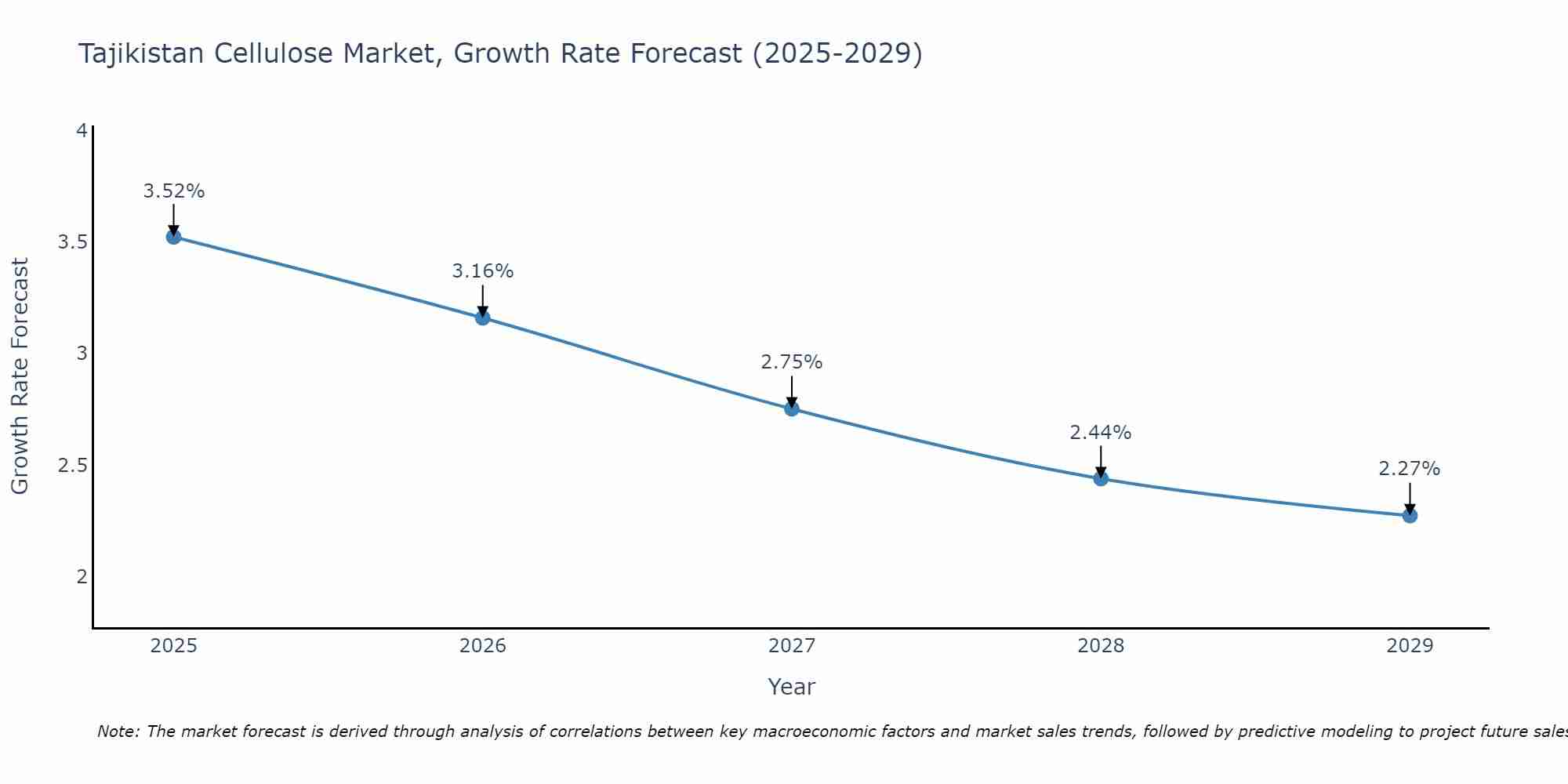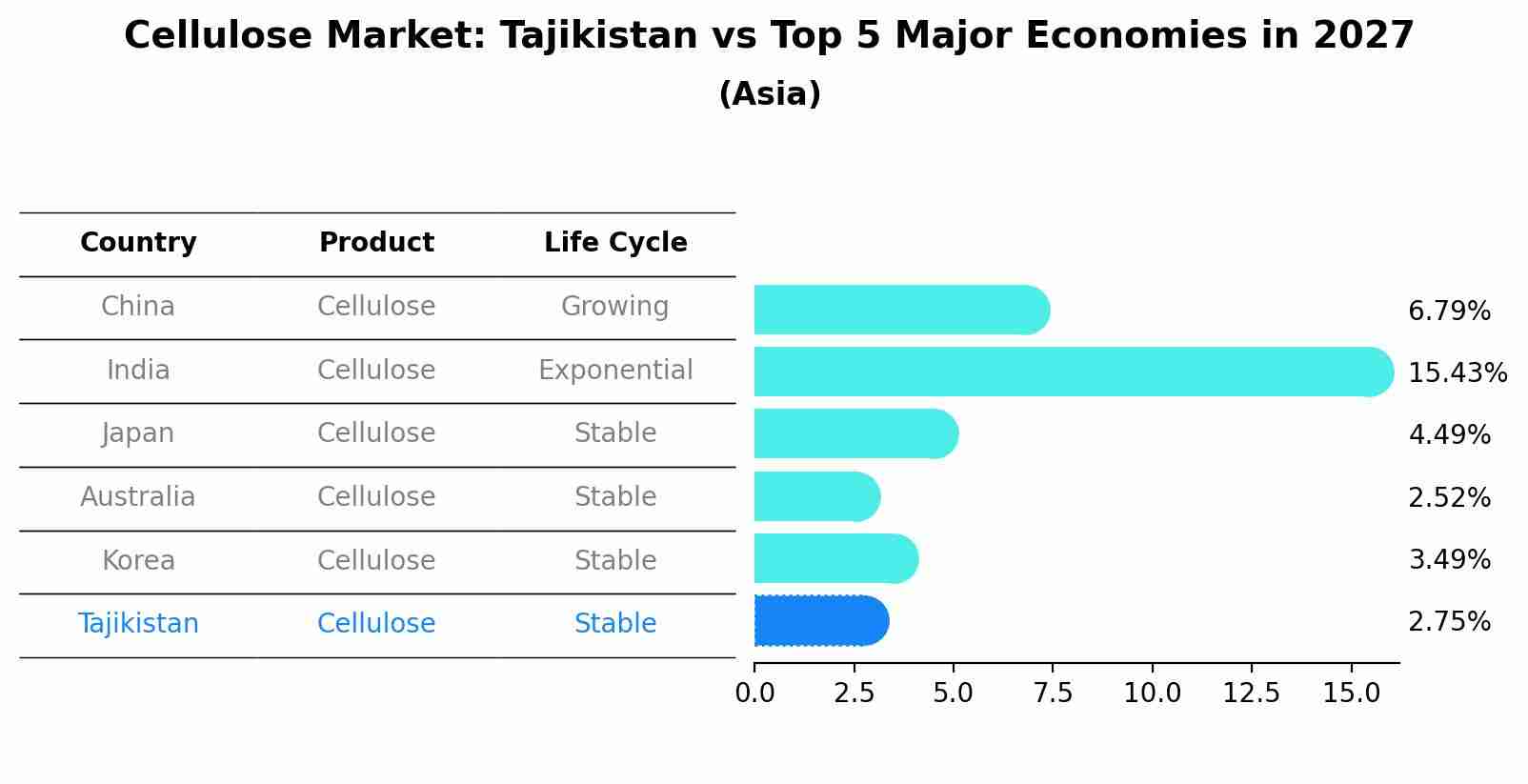Tajikistan Cellulose Market (2025-2031) Outlook | Companies, Growth, Analysis, Forecast, Value, Trends, Share, Size, Revenue & Industry
| Product Code: ETC073998 | Publication Date: Jun 2021 | Updated Date: Jun 2025 | Product Type: Report | |
| Publisher: 6Wresearch | Author: Dhaval Chaurasia | No. of Pages: 70 | No. of Figures: 35 | No. of Tables: 5 |
Tajikistan Cellulose Market Size Growth Rate
The Tajikistan Cellulose Market could see a tapering of growth rates over 2025 to 2029. Beginning strongly at 3.52% in 2025, growth softens to 2.27% in 2029.

Cellulose Market: Tajikistan vs Top 5 Major Economies in 2027 (Asia)
By 2027, the Cellulose market in Tajikistan is anticipated to reach a growth rate of 2.75%, as part of an increasingly competitive Asia region, where China remains at the forefront, supported by India, Japan, Australia and South Korea, driving innovations and market adoption across sectors.

Tajikistan Cellulose Market Overview
The Tajikistan Cellulose Market is characterized by steady growth driven by the increasing demand for cellulose-based products across various industries such as paper, textiles, and pharmaceuticals. The market is primarily dominated by local players with a few international companies also holding a significant market share. The production of cellulose in Tajikistan is largely focused on wood-derived sources, with a growing emphasis on sustainable and eco-friendly practices. The market is expected to witness further expansion in the coming years, fueled by investments in modern manufacturing technologies and a rising awareness of the benefits of cellulose-based products. However, challenges such as limited infrastructure and access to advanced technology may hinder the market`s full potential unless addressed effectively.
Tajikistan Cellulose Market Trends
The Tajikistan Cellulose Market is showing a growing trend towards sustainable and eco-friendly products, driven by increasing consumer awareness and demand for environmentally responsible goods. Manufacturers in Tajikistan are focusing on developing cellulose-based products that are biodegradable and compostable, in line with global sustainability goals. Additionally, there is a rising interest in utilizing cellulose in innovative applications such as packaging materials, textiles, and bio-based plastics. The market is also witnessing investments in research and development to enhance the quality and performance of cellulose products. Overall, the Tajikistan Cellulose Market is evolving towards a more sustainable and environmentally conscious direction, catering to the changing preferences of consumers and aligning with the global shift towards green technologies and materials.
Tajikistan Cellulose Market Challenges
In the Tajikistan Cellulose Market, several challenges are faced, including limited domestic production capacity, inadequate infrastructure for processing raw materials, and dependence on imported cellulose products. The lack of modern technology and equipment hinders the efficiency and competitiveness of local cellulose manufacturers. Additionally, inconsistent government policies and regulations often create uncertainties for businesses operating in the market. Limited access to financing and investment opportunities further restrict the growth potential of the cellulose industry in Tajikistan. Addressing these challenges will be crucial in developing a sustainable and thriving cellulose market in the country.
Tajikistan Cellulose Market Investment Opportunities
The Tajikistan Cellulose Market presents several investment opportunities due to the country`s abundant forest resources and growing demand for cellulose products. Investors can consider opportunities in establishing or expanding pulp and paper mills, producing wood pulp for various industries such as packaging, textiles, and construction. Additionally, investing in modernizing existing facilities to improve efficiency and sustainability can also be a lucrative option. With increasing global demand for eco-friendly and sustainable products, the Tajikistan Cellulose Market offers potential for growth and profitability in the long term. However, potential investors should conduct thorough market research, assess regulatory frameworks, and consider factors such as infrastructure and transportation logistics before making investment decisions in this sector.
Tajikistan Cellulose Market Government Policy
The Tajikistan government has implemented policies to support the development of the country`s cellulose market. These policies include providing financial incentives and subsidies to encourage investment in the industry, promoting research and development initiatives to enhance product quality and competitiveness, and implementing regulations to ensure environmental sustainability and resource management. Additionally, the government has established partnerships with international organizations to facilitate technology transfer and market access for Tajikistan`s cellulose products. Overall, these policies aim to stimulate growth in the cellulose market, create employment opportunities, and contribute to the country`s economic development.
Tajikistan Cellulose Market Future Outlook
The Tajikistan Cellulose Market is poised for growth in the coming years, driven by increasing demand for sustainable and eco-friendly products across various industries. With a growing focus on reducing environmental impact, cellulose-based materials are gaining popularity as alternatives to traditional plastics and synthetic fibers. The market is expected to benefit from advancements in technology and innovation, leading to the development of new and improved cellulose-derived products. Additionally, government initiatives promoting the use of renewable resources and sustainable practices are likely to further boost the market in Tajikistan. Overall, the future outlook for the Tajikistan Cellulose Market appears positive, with opportunities for expansion and diversification in the near future.
Key Highlights of the Report:
- Tajikistan Cellulose Market Outlook
- Market Size of Tajikistan Cellulose Market, 2021
- Forecast of Tajikistan Cellulose Market, 2031
- Historical Data and Forecast of Tajikistan Cellulose Revenues & Volume for the Period 2021 - 2031
- Tajikistan Cellulose Market Trend Evolution
- Tajikistan Cellulose Market Drivers and Challenges
- Tajikistan Cellulose Price Trends
- Tajikistan Cellulose Porter's Five Forces
- Tajikistan Cellulose Industry Life Cycle
- Historical Data and Forecast of Tajikistan Cellulose Market Revenues & Volume By Fiber Type for the Period 2021 - 2031
- Historical Data and Forecast of Tajikistan Cellulose Market Revenues & Volume By Natural Cellulose Fibers for the Period 2021 - 2031
- Historical Data and Forecast of Tajikistan Cellulose Market Revenues & Volume By Man-made Cellulose Fibers for the Period 2021 - 2031
- Historical Data and Forecast of Tajikistan Cellulose Market Revenues & Volume By Applications for the Period 2021 - 2031
- Historical Data and Forecast of Tajikistan Cellulose Market Revenues & Volume By Apparel for the Period 2021 - 2031
- Historical Data and Forecast of Tajikistan Cellulose Market Revenues & Volume By Home Textile for the Period 2021 - 2031
- Historical Data and Forecast of Tajikistan Cellulose Market Revenues & Volume By Industrial for the Period 2021 - 2031
- Historical Data and Forecast of Tajikistan Cellulose Market Revenues & Volume By Others for the Period 2021 - 2031
- Tajikistan Cellulose Import Export Trade Statistics
- Market Opportunity Assessment By Fiber Type
- Market Opportunity Assessment By Applications
- Tajikistan Cellulose Top Companies Market Share
- Tajikistan Cellulose Competitive Benchmarking By Technical and Operational Parameters
- Tajikistan Cellulose Company Profiles
- Tajikistan Cellulose Key Strategic Recommendations
Frequently Asked Questions About the Market Study (FAQs):
1 Executive Summary |
2 Introduction |
2.1 Key Highlights of the Report |
2.2 Report Description |
2.3 Market Scope & Segmentation |
2.4 Research Methodology |
2.5 Assumptions |
3 Tajikistan Cellulose Market Overview |
3.1 Tajikistan Country Macro Economic Indicators |
3.2 Tajikistan Cellulose Market Revenues & Volume, 2021 & 2031F |
3.3 Tajikistan Cellulose Market - Industry Life Cycle |
3.4 Tajikistan Cellulose Market - Porter's Five Forces |
3.5 Tajikistan Cellulose Market Revenues & Volume Share, By Fiber Type, 2021 & 2031F |
3.6 Tajikistan Cellulose Market Revenues & Volume Share, By Applications, 2021 & 2031F |
4 Tajikistan Cellulose Market Dynamics |
4.1 Impact Analysis |
4.2 Market Drivers |
4.3 Market Restraints |
5 Tajikistan Cellulose Market Trends |
6 Tajikistan Cellulose Market, By Types |
6.1 Tajikistan Cellulose Market, By Fiber Type |
6.1.1 Overview and Analysis |
6.1.2 Tajikistan Cellulose Market Revenues & Volume, By Fiber Type, 2018 - 2027F |
6.1.3 Tajikistan Cellulose Market Revenues & Volume, By Natural Cellulose Fibers, 2018 - 2027F |
6.1.4 Tajikistan Cellulose Market Revenues & Volume, By Man-made Cellulose Fibers, 2018 - 2027F |
6.2 Tajikistan Cellulose Market, By Applications |
6.2.1 Overview and Analysis |
6.2.2 Tajikistan Cellulose Market Revenues & Volume, By Apparel, 2018 - 2027F |
6.2.3 Tajikistan Cellulose Market Revenues & Volume, By Home Textile, 2018 - 2027F |
6.2.4 Tajikistan Cellulose Market Revenues & Volume, By Industrial, 2018 - 2027F |
6.2.5 Tajikistan Cellulose Market Revenues & Volume, By Others, 2018 - 2027F |
7 Tajikistan Cellulose Market Import-Export Trade Statistics |
7.1 Tajikistan Cellulose Market Export to Major Countries |
7.2 Tajikistan Cellulose Market Imports from Major Countries |
8 Tajikistan Cellulose Market Key Performance Indicators |
9 Tajikistan Cellulose Market - Opportunity Assessment |
9.1 Tajikistan Cellulose Market Opportunity Assessment, By Fiber Type, 2021 & 2031F |
9.2 Tajikistan Cellulose Market Opportunity Assessment, By Applications, 2021 & 2031F |
10 Tajikistan Cellulose Market - Competitive Landscape |
10.1 Tajikistan Cellulose Market Revenue Share, By Companies, 2021 |
10.2 Tajikistan Cellulose Market Competitive Benchmarking, By Operating and Technical Parameters |
11 Company Profiles |
12 Recommendations |
13 Disclaimer |
- Single User License$ 1,995
- Department License$ 2,400
- Site License$ 3,120
- Global License$ 3,795
Search
Related Reports
- Vietnam System Integrator Market (2025-2031) | Size, Companies, Analysis, Industry, Value, Forecast, Growth, Trends, Revenue & Share
- ASEAN and Thailand Brain Health Supplements Market (2025-2031) | Strategy, Consumer Insights, Analysis, Investment Trends, Opportunities, Growth, Size, Share, Industry, Revenue, Segments, Value, Segmentation, Supply, Forecast, Restraints, Outlook, Competition, Drivers, Trends, Demand, Pricing Analysis, Competitive, Strategic Insights, Companies, Challenges
- ASEAN Bearings Market (2025-2031) | Strategy, Consumer Insights, Analysis, Investment Trends, Opportunities, Growth, Size, Share, Industry, Revenue, Segments, Value, Segmentation, Supply, Forecast, Restraints, Outlook, Competition, Drivers, Trends, Demand, Pricing Analysis, Competitive, Strategic Insights, Companies, Challenges
- Europe Flooring Market (2025-2031) | Outlook, Share, Industry, Trends, Forecast, Companies, Revenue, Size, Analysis, Growth & Value
- Saudi Arabia Manlift Market (2025-2031) | Outlook, Size, Growth, Trends, Companies, Industry, Revenue, Value, Share, Forecast & Analysis
- Uganda Excavator, Crane, and Wheel Loaders Market (2025-2031) | Strategy, Consumer Insights, Analysis, Investment Trends, Opportunities, Growth, Size, Share, Industry, Revenue, Segments, Value, Segmentation, Supply, Forecast, Restraints, Outlook, Competition, Drivers, Trends, Demand, Pricing Analysis, Competitive, Strategic Insights, Companies, Challenges
- Rwanda Excavator, Crane, and Wheel Loaders Market (2025-2031) | Strategy, Consumer Insights, Analysis, Investment Trends, Opportunities, Growth, Size, Share, Industry, Revenue, Segments, Value, Segmentation, Supply, Forecast, Restraints, Outlook, Competition, Drivers, Trends, Demand, Pricing Analysis, Competitive, Strategic Insights, Companies, Challenges
- Kenya Excavator, Crane, and Wheel Loaders Market (2025-2031) | Strategy, Consumer Insights, Analysis, Investment Trends, Opportunities, Growth, Size, Share, Industry, Revenue, Segments, Value, Segmentation, Supply, Forecast, Restraints, Outlook, Competition, Drivers, Trends, Demand, Pricing Analysis, Competitive, Strategic Insights, Companies, Challenges
- Angola Excavator, Crane, and Wheel Loaders Market (2025-2031) | Strategy, Consumer Insights, Analysis, Investment Trends, Opportunities, Growth, Size, Share, Industry, Revenue, Segments, Value, Segmentation, Supply, Forecast, Restraints, Outlook, Competition, Drivers, Trends, Demand, Pricing Analysis, Competitive, Strategic Insights, Companies, Challenges
- Israel Intelligent Transport System Market (2025-2031) | Strategy, Consumer Insights, Analysis, Investment Trends, Opportunities, Growth, Size, Share, Industry, Revenue, Segments, Value, Segmentation, Supply, Forecast, Restraints, Outlook, Competition, Drivers, Trends, Demand, Pricing Analysis, Competitive, Strategic Insights, Companies, Challenges
Industry Events and Analyst Meet
Our Clients
Whitepaper
- Middle East & Africa Commercial Security Market Click here to view more.
- Middle East & Africa Fire Safety Systems & Equipment Market Click here to view more.
- GCC Drone Market Click here to view more.
- Middle East Lighting Fixture Market Click here to view more.
- GCC Physical & Perimeter Security Market Click here to view more.
6WResearch In News
- Doha a strategic location for EV manufacturing hub: IPA Qatar
- Demand for luxury TVs surging in the GCC, says Samsung
- Empowering Growth: The Thriving Journey of Bangladesh’s Cable Industry
- Demand for luxury TVs surging in the GCC, says Samsung
- Video call with a traditional healer? Once unthinkable, it’s now common in South Africa
- Intelligent Buildings To Smooth GCC’s Path To Net Zero













